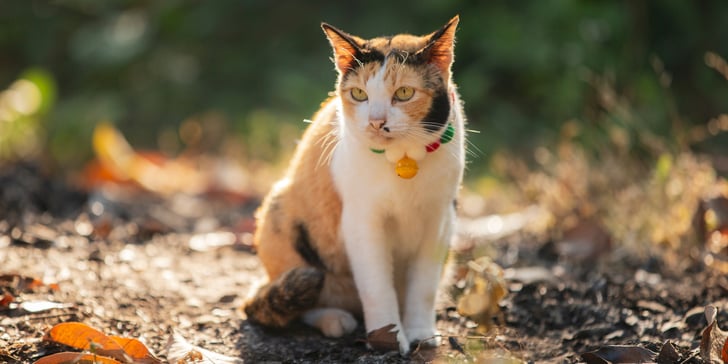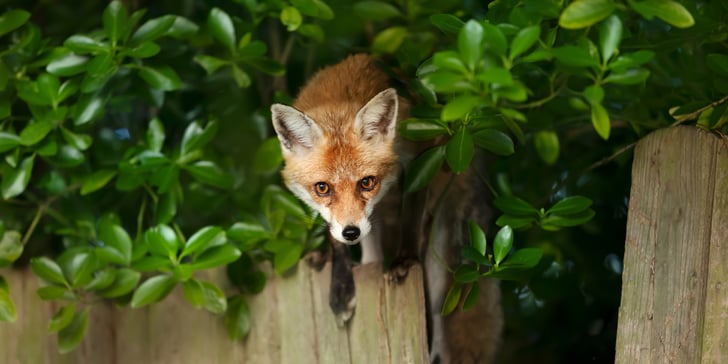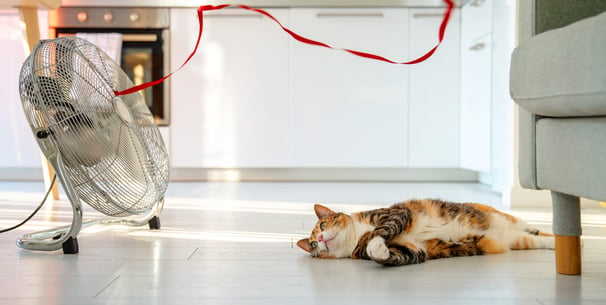Do Foxes Attack Cats? Urban Wildlife Insights
Index:



Do foxes pose a real danger to your pet cat? Urban wildlife insights on fox attacks
As the golden hues of dusk settle over our urban landscapes, a hush falls, and nature's nocturnal procession begins. It's a time when our beloved pet cats might prowl the gardens. Yet, under the shroud of twilight, concern creeps into the hearts of many cat owners.
The question permeates the air: do foxes attack cats? And are these russet-coated creatures a danger to cats in our towns and cities?
The worry we hold for our pet cats is profound and wrapped in an instinct to protect. But are foxes a real danger, or is it a misconception of urban wildlife insights?
Key takeaways
Fox attacks on pet cats are unusual, particularly involving healthy adult cats.
A pet cat's greater risk comes from territorial disputes with other cats, not foxes.
Maintain your garden in a way that doesn't attract foxes to minimise potential encounters.
Practical measures like supervising and bringing your cats in at night can protect them.
Regular veterinary care and vaccinations remain crucial for your cat’s well-being.



Are foxes naturally predisposed to attack cats?
In urban landscapes, the common fox has evolved quite differently from its rural kin, exhibiting behaviours unique to the city setting where they now thrive.
Just as urban foxes have become adept at utilising resources in their concrete jungle, cats exhibit unique behaviours influenced by their environment and their need for safety, such as their fascination with boxes, a topic explored in-depth in our article on why cats like boxes.
Exploring the natural diet of urban foxes
A beloved pet being taken by foxes is a stark contrast to the mundane truth of urban foxes' less dramatic scavenging diet.
Urban foxes have become adept at utilising the resources available within their concrete jungle. These foxes are scavengers primarily, feeding on small mammals, birds, and even fruits, as well as embracing any edible scraps discarded by humans.
Urban foxes are still hunters - their diet reflects the opportunistic nature of foxes' hunt patterns, which are more focused on easily accessible food rather than posing a threat to pet cats or the energy-intensive task of killing cats.
The territorial nature of foxes and cats
Like cats, foxes are generally shy creatures, disinclined to engage in unnecessary confrontation. While both cats and foxes claim territories within the urban environment, their interactions tend to be characterised by avoidance rather than aggression.
When territories overlap, it is the rare occasion rather than the common trend that leads to a threat to cats.
Risk assessment: the likelihood of a fox attack on a pet cat
The actual risk of a fox attack is considered minimal. Incidents of a direct attack by a fox are notably scarce, and urban foxes are not usually involved in the killing of cats.
These creatures' natural timidity, coupled with an adult cat's ability to fend for itself, means such events are uncommon.
Disease transmission between the two species is also a relatively rare occurrence.
Here’s a table that articulates the reality behind encounters of foxes and cats in an urban setting:
This clear juxtaposition illustrates that the inherent behaviours and preferences of urban foxes and domestic cats significantly reduce the risk of a fox attack, confirming that, while vigilance is necessary, there is no cause for exaggerated concern.



Real-life incidents - documented cases of foxes attacking cats
Though rare, documented incidents where domesticated felines have been attacked by a fox are present in urban wildlife reports. As a result, attention must be given to more vulnerable members of the feline community.
Much like the uncommon instances of fox attacks on cats, myths surrounding black cats have persisted through time, often overshadowing the facts.
Discover the truth behind these myths and how they compare to the misconceptions about foxes in our article on Black Cats: Myths and Facts Revealed.
Analysing reports of fox attacks on cats in urban areas
Investigations into reports of foxes attacking pets reveal that such episodes are exceptions rather than a common threat.
Despite fear-inducing stories, the frequency of reports wherein cats are killed by foxes remains low.
How do cat injuries from fox attacks compare to those from other cats or wildlife?
Predominantly, injuries that felines sustain are due to fights with other cats rather than wildlife confrontations.
Veterinary records rarely substantiate claims of felines being fatally wounded in fox fights, suggesting a need for robust scrutiny when such occurrences are suspected.
The debate on foxes' threat level to pet cats among wildlife experts
Discussions among wildlife conservationists shed light on the complexity of urban ecosystems, reminding us that sightings of foxes are not necessarily signals of conflict.
Even stories of cats chasing foxes contribute interesting twists to the ongoing debate. Such interactions underscore the adaptability and instincts of both species riding the fine line between curiosity and confrontation.
More common threats to cats are parasites such as mites. Read our blog on how to recognise and treat mites here.



Preventive measures: How to keep your cat safe from potential fox threats
As urban fox populations continue to thrive, keeping your pet cat safeguarded against potential risks becomes increasingly significant. Implementing effective strategies to ensure your cat's safety requires a combination of indoor vigilance and outdoor awareness.
Effective strategies to keep your cat safe indoors and outdoors
Ensuring the welfare of your cat starts with keeping your cat indoors, especially during the night when foxes are most active. When outdoors, attentive supervision is critical for maintaining your cat’s safety.
By offering your pet cat a secure night-time environment and monitoring outdoor play, you substantially lessen the likelihood of fox encounters.
Using technology and environment modifications for safety
A good starting point for preventative measures is keeping foxes from your garden. Secure bins and remove leftovers to prevent attracting these opportunistic feeders.
Installing movement-sensor lighting can act as an effective fox-away mechanism, keeping your outdoor space less inviting to curious foxes.
To assist in maintaining your cat indoors at night, consider a microchip-activated cat flap that exclusively permits entry to your pet cat, thereby preventing any uninvited four-legged guests.
The role of supervised playtime in preventing fox encounters
Structured and supervised playtime plays a pivotal role in the well-being of your indoor cat.
Such play not only provides necessary exercise and stimulation but also reduces the allure of the outdoors, where your cat may encounter urban wildlife.
Routine calls for your pet to return indoors can further enhance their security and establish beneficial behaviour patterns.
Keeping your cat indoors at night will help to keep your cat safe from foxes and other urban wildlife. For tips on managing your indoor cat's stress and aggression, including spitting and hissing, check out our guide on how to prevent your cat from spitting and hissing.
Community efforts in managing urban fox populations safely
Collaborative community efforts play an integral role in wildlife management.
Whether it involves sharing knowledge on how to scare the foxes away or supporting the 200 practices across the UK that contribute to wildlife care, every action counts.
Enhancing awareness amongst residents about the problems with foxes without disturbing the ecological balance is a pivotal step.
Diligent measures and informed actions can significantly reduce the chances of encounters between our pets and urban foxes.
With foxes often seen but not necessarily as a perpetual threat, maintaining a vigilant yet compassionate stance towards these natural inhabitants could lead to a harmonious community environment.
Behavioural observations: How cats and foxes interact in urban settings
Encounters between foxes and cats often result in a game of assessment and evasion. Cats are territorial animals and will stand guard, particularly if another cat enters their domain.
However, when it comes to dealing with foxes, they are likely to assess the size and strength of the fox before deciding on their next move.
While a family of foxes may display curious behaviour towards felines, aggressive incidents are rare. Foxes often look for the path of least resistance in avoiding confrontation, understanding that an altercation with a cat could lead to injury.
Coping strategies of cats when encountering foxes
Cats at night are particularly vigilant and utilise their well-honed senses to detect the presence of foxes.
Their strategies vary from swift retreat to a display of assertive body language meant to intimidate or deter potential threats.
Despite their smaller size, cats are well-equipped with sharp claws and agility, factors that a contemplating fox would have to seriously consider.
Understanding the fight or flight response in foxes and cats during encounters
The instinctual response of fight or flight is evident in both foxes and cats. A dog and cat encounter may quickly escalate due to the natural predator-prey dynamic, whereas foxes often lean towards flight, valuing self-preservation over territorial disputes.
Cats, too, may opt to flee if the risk is deemed too great or if the fox
appears overly assertive.
Understanding these responses is crucial for urban dwellers when encountering or dealing with foxes and their pet cats to ensure that interactions remain non-conflictual.



Common myths vs. facts: The true nature of fox attacks on cats
Debunking myths about the predatory nature of foxes towards cats
Despite the persistence of folklore, it has been verified through research that cats are much more likely to suffer injuries from a fight with another cat than become the prey of a fox.
The notion of foxes being a systematic threat to pet cats is not upheld by scientific data, suggesting the risk of a true predator-prey dynamic is remote.
Nonetheless, many still mistakenly hold onto the idea that foxes eat cats when, in reality, dead-cat incidents by foxes are rare.



Answering your questions...
Do foxes pose a real danger to your pet cat?
Foxes are often seen as a potential threat to pet cats, particularly kittens, the elderly, or those with illnesses or injuries.
However, a healthy adult cat typically has the means to defend itself, making actual fox attacks relatively rare. Urban wildlife insights indicate that foxes generally avoid confrontations with cats.
Are foxes naturally predisposed to attack cats?
No, foxes are not naturally predisposed to attack cats. They are scavengers and predators that prefer easy prey and are generally shy animals.
Their natural diet mainly comprises small mammals, birds, and fruits, and they'll scavenge for human refuse rather than seek out fights with cats.
What is the likelihood of a fox attack on a pet cat?
While possible, the likelihood of a fox attack on a pet cat is low, particularly for adult cats in good health.
Most injuries to cats are caused by other cats rather than wildlife like foxes.
Keeping a cat indoors at night can further reduce the minimal risk of a fox attack.
Are there documented cases of foxes attacking cats?
There have been some documented cases of foxes attacking cats, but they are not common. In urban areas, where wildlife experts frequently observe the interactions of these animals, such attacks are rare and often involve vulnerable cats.
How can I keep my cat safe from potential fox threats?
Keeping your cat indoors at night, using secure cat flaps, removing food sources from your garden that attract foxes, and implementing motion-sensing lights can all help keep your cat safe.
Educating neighbourhoods and using community efforts to manage wildlife also play a crucial role.
How do urban foxes' diets impact the safety of pet cats?
Urban foxes typically have a diet that is quite different from their rural counterparts, focusing on scavenging and smaller prey available in cities, which reduces the likelihood of them targeting pet cats as food sources.
How can the community help keep both pets and foxes safe?
Community efforts can help educate residents about preventing attracting foxes, such as securing trash bins and not leaving pet food outdoors. This collective action helps deter foxes naturally and minimises potential encounters between foxes and domestic pets.
What are the typical behaviours of cats and foxes during encounters?
During encounters, cats and foxes typically display behaviours aimed at minimising conflict. Cats may stand their ground or retreat, while foxes tend to exhibit a fight or flight response, often choosing to back away rather than escalate the situation.
Are foxes a significant threat to pet cats compared to other dangers?
No, foxes are not considered a significant threat to pet cats when compared to other dangers such as traffic accidents or fights with other cats.
Most fox encounters with cats do not result in aggression, and foxes are generally not inclined to attack healthy adult cats.
How has urbanisation impacted fox and cat encounters?
Urbanisation has created environments where foxes have adapted to the presence of humans and domestic animals, including cats.
Urban-based foxes are more likely to scavenge and avoid confrontations with pets. Proper management of pets' outdoor time and secure housing can help navigate potential fox and cat encounters.
Waggel Pet Insurance
Need more help? You're in luck if you're a Waggel Pet Insurance member. Along with our excellent coverage, we offer access to a 24/7 online vet to answer all your sticky questions, especially if you need grooming assistance.
Not a member? Why not get a quote now and cover your furry friend for a range of illnesses, all while enjoying our amazing perks and rewards.
Want more like this?
Get updates from us with helpful info, advice, answers to frequently asked questions and much more.
Index:
- Do foxes pose a real danger to your pet cat? Urban wildlife insights on fox attacks
- Are foxes naturally predisposed to attack cats?
- Real-life incidents - documented cases of foxes attacking cats
- Preventive measures: How to keep your cat safe from potential fox threats
- Common myths vs. facts: The true nature of fox attacks on cats
- Answering your questions...
Related posts:
Get your quote
Along with our excellent coverage, we offer access to a 24/7 online vet to answer all your sticky questions.





